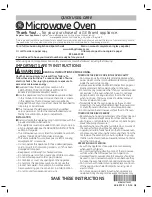
Microwave
What are Microwaves?
Microwaves, like visible light, are a part of the electromagnetic radiation
spectrum. They are extremely high frequency radio waves. As the frequency of
radiation increases, its wavelength decreases. The very high frequencies
correspond to very short wavelengths; hence the name microwaves. Infrared
radiation, ultraviolet light and X-rays are also electromagnetic radiations, but
have even shorter wavelengths than microwaves.
Microwaves absorption and reflectivity are functions of the matter subjected to
them. Metallic surfaces are good reflectors of microwaves. However, electrically
non-conductive materials allow microwave to pass through them with very little
absorption. All other materials that fall between metals and electrical isolators
absorb microwave at different rates. Materials containing moisture, such as food
and even people, absorb microwave energy. If energy is absorbed at a rate
greater than the rate at which the material looses energy (rate of cooling), its
temperature increases.
How do microwaves cook?
In microwave ovens, magnetrons are used to produce the microwaves. These
microwaves have a frequency of 2,450 MHz, which is transmitted into the
enclosed metal oven cavity. In the cavity, they are reflected by the oven walls
and absorbed in food or drink placed in the oven.
Microwaves continuously reverse the polarity of the food molecules a
tremendous number of times (2,450,000,000 times per second). This causes
molecular agitation and thus friction, which produces heat and results in a rapid
rise in temperature. Cooking time is usually much shorter than in a conventional
oven.
The rate of heating depends on the type of food, its shape, volume, and mass.
The oven walls are not directly heated by microwaves, as they do not absorb
microwave energy. However, the inside of the oven may feel warm due to the
presence of the hot food and the heat generated by the electrical circuits.
1







































